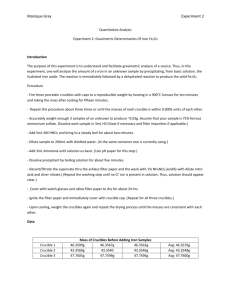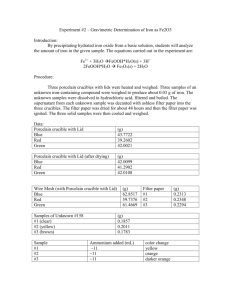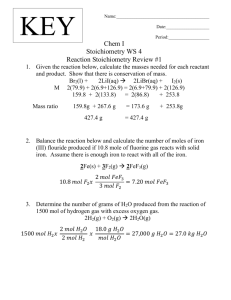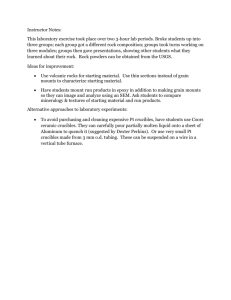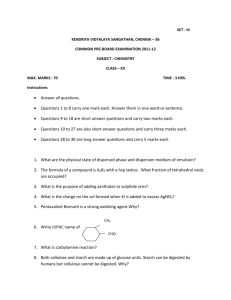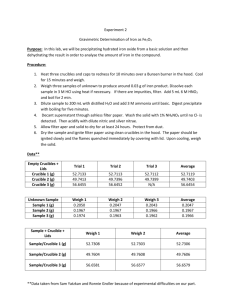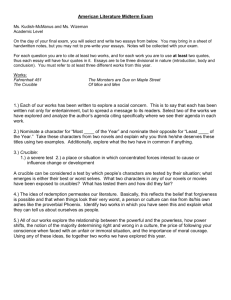Experiment Two - Gravimetric Determination of Iron as Fe2O3
advertisement
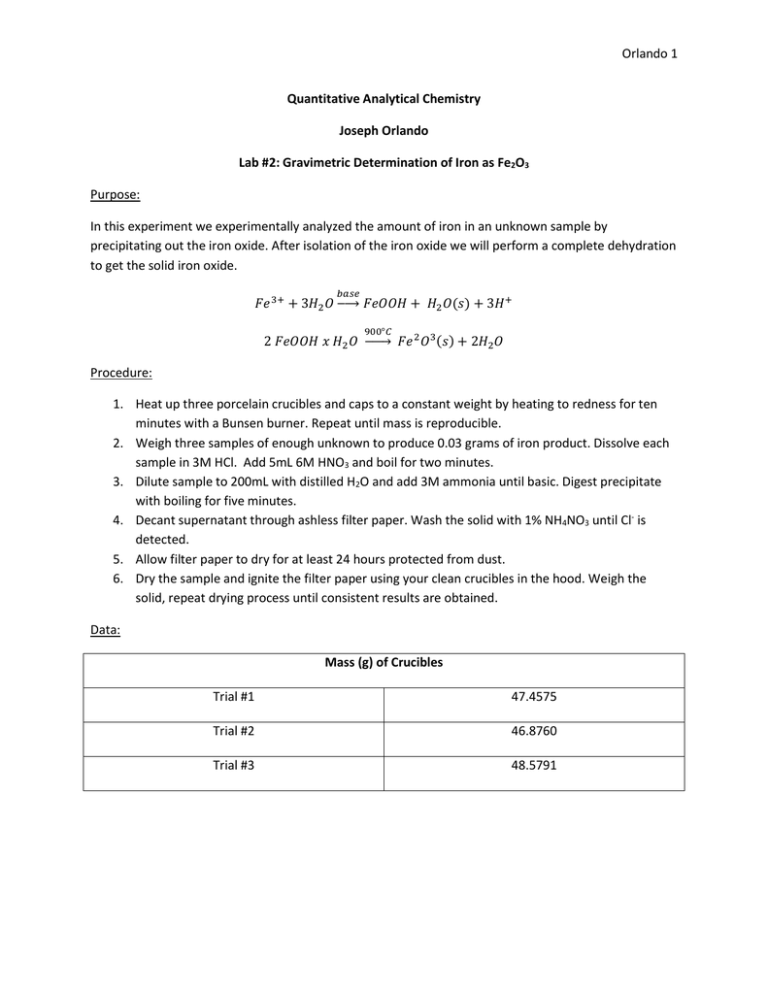
Orlando 1 Quantitative Analytical Chemistry Joseph Orlando Lab #2: Gravimetric Determination of Iron as Fe2O3 Purpose: In this experiment we experimentally analyzed the amount of iron in an unknown sample by precipitating out the iron oxide. After isolation of the iron oxide we will perform a complete dehydration to get the solid iron oxide. 𝑏𝑎𝑠𝑒 𝐹𝑒 3+ + 3𝐻2 𝑂 → 𝐹𝑒𝑂𝑂𝐻 + 𝐻2 𝑂(𝑠) + 3𝐻 + 900°𝐶 2 𝐹𝑒𝑂𝑂𝐻 𝑥 𝐻2 𝑂 → 𝐹𝑒 2 𝑂3 (𝑠) + 2𝐻2 𝑂 Procedure: 1. Heat up three porcelain crucibles and caps to a constant weight by heating to redness for ten minutes with a Bunsen burner. Repeat until mass is reproducible. 2. Weigh three samples of enough unknown to produce 0.03 grams of iron product. Dissolve each sample in 3M HCl. Add 5mL 6M HNO3 and boil for two minutes. 3. Dilute sample to 200mL with distilled H2O and add 3M ammonia until basic. Digest precipitate with boiling for five minutes. 4. Decant supernatant through ashless filter paper. Wash the solid with 1% NH4NO3 until Cl- is detected. 5. Allow filter paper to dry for at least 24 hours protected from dust. 6. Dry the sample and ignite the filter paper using your clean crucibles in the hood. Weigh the solid, repeat drying process until consistent results are obtained. Data: Mass (g) of Crucibles Trial #1 47.4575 Trial #2 46.8760 Trial #3 48.5791 Orlando 2 Mass (g) of Fe2O3 product 0.1587 Mass (g) of Fe % Fe in Fe2O3 Trial #1 Mass (g) of Unknown Used 0.1334 0.1110 69.94% % Fe in Unknown 83.21% Trial #2 0.1330 0.3101 0.2169 69.94% 163.08% Trial #3 0.1341 0.1801 0.1260 69.96% 93.96% Average 0.1335 0.2163 0.1513 69.95% 145.10% Equations: Mass of Unknown: . 03g Fe2 O3 × 1 mol Fe2 O3 2 mol FeOOH 1 mol Unknown 265.975g Unknown 1 × × × × = 0.13g 159.69g Fe2 O3 1 mol Fe2 O3 1 mol FeOOH 1 mol . 75 = Mass of Product + Crucible − Mass of Crucible Mass (g) Fe2O3 Product: Mass (g) of Fe: = g Fe2 O3 × %Fe in Fe2O3: = 𝒈 𝑭𝒆 𝒈 Fe2 O3 %Fe in Unknown Sample: = mol Fe2 O3 159.692 g Fe2 O3 × 2 mol Fe 1 mol Fe2 O3 × 55.85 g Fe 1 mol Fe × 𝟏𝟎𝟎% 𝒈 𝑭𝒆 𝒈 Unknown × 𝟏𝟎𝟎% Conclusion: The purpose of this experiment was to determine the amount of iron in an unknown sample. After the experimental data had been obtained it was calculated that the unknown sample contained an average of 145.10% Fe. Two of the trials resulted in an 83.21% and 93.96% Fe content while one of the trials resulted in a 163.08% Fe content. It is believed that the 163.08% Fe content result was due to a mix up with the crucibles and crucible lids. A different crucible lid may have been used when initially weighing the crucible then when weighing the final product. For further experiments, great consideration will be taken in specifically labeling any crucibles/glassware used. Post Lab Questions: 1. What do you consider the single most significant source of error in this experiment? Do your results justify this answer? The single most significant source of error in this experiment in my opinion was the transferring of the product several times to and from the crucible. This transferring allows for much of the product to be lost on the glassware that was used. This will decrease the percent yield that was obtained. Orlando 3 2. What was the function of the nitric acid in step two? Nitric acid was used as an oxidizing agent to convert Fe2+ to Fe3+. 3. What does the term gravimetric analysis mean? Gravimetric analysis is a method of quantitative chemical analysis in which the analyte is made into a solution of known makeup. This analyte can later be separated and massed to determine its own composition. 4. What modifications would you make to improve this experiment? I would recommend using a different method for heating the crucibles (maybe Bunsen burners instead) because it is very difficult to maneuver the crucibles in and out. Also I would clarify in the procedure on what is to be done in the filtration steps.
